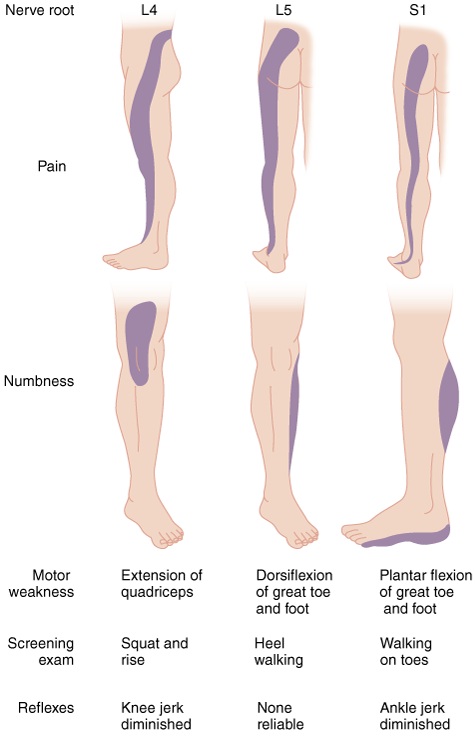Lower back pain
Background
- Pain lasting >6wks is risk factor for more serious disease
- Night pain and unrelenting pain are worrisome symptoms
- Back pain in IV drug user is spinal infection until proven otherwise
- 95% of herniated discks occur at L4-L5 or L5-S1 (for both pain extends below the knee)
Clinical Features
- See Back Pain (Red Flags)
- Musculoskeletal pain
- Located primarily in the back w/ possible radiation into the buttock/thighs
- Pain worse w/ movement but improves w/ rest
- Spinal stenosis
- Bilateral sciatic pain worsened by walking (pseudoclaudication), prolonged standing **Pain relieved by forward flexion
- Sciatica
- Radicular back pain in the distribution of a lumbar or sacral nerve root
- Anything that compresses the nerve roots, cauda equina, or cord can cause sciatica
- Pain worsened by coughing, Valsalva, sitting; relieved by lying in supine position
- Occurs in only 1% of pts w/ back pain
- Present in 95% of pts who have a symptomatic herniated disk
- Radicular back pain in the distribution of a lumbar or sacral nerve root
DDX
- See Back Pain (DDX)
Work-Up
- Pregnancy test
- Exam
- Straight leg raise testing
- Screening exam for a herniated disk (Sn 68-80%)
- Lifting leg causes radicular pain of affected leg radiating to BELOW the knee
- Pain is worsened by ankle dorsiflexion
- Crossed Straight leg raise testing (high Sp, low Sn)
- Lifting the asymptomatic leg causes radicular pain down the affected leg
- Nerve root compromise
- Rectal exam (if concerned for cord compression)
- Straight leg raise testing
- Labs
- Only necessary if concerned for infection, tumor, or rheumatologic cause
- CBC, UA, ESR (90-98% Sn for infectious etiology)
- Only necessary if concerned for infection, tumor, or rheumatologic cause
- Imaging
- Plain films
- Only necessary if suspect fracture, tumor, or infection
- MRI
- Only necessary if suspect infection, neoplasm, epidural compression syndromes
- Consider for back pain >6-8wks
- US
- Rule-out AAA
- Plain films
Treatment
- Nonspecific Back Pain (musculoskeletal)
- Instruct to continue daily activities using pain as limiting factor
- Meds
- NSAIDs or acetaminophen
- 1st line therapy
- Opioids
- Appropriate for moderate-severe pain but only for limited duration (1-2wks)
- Muscle relaxants
- Efficacy appears equal to NSAIDs
- Diazepam 5-10mg PO q6-8hr OR methocarbamol 1000-1500mg PO QID
- NSAIDs or acetaminophen
- Sciatica
- Treatment is the same as for musculoskeletal back pain
- 80% of pts will ultimately improve without surgery
- Spinal Stenosis
- Treatment is the same as for musculoskeletal back pain
See Also
Source
- Tintinalli



